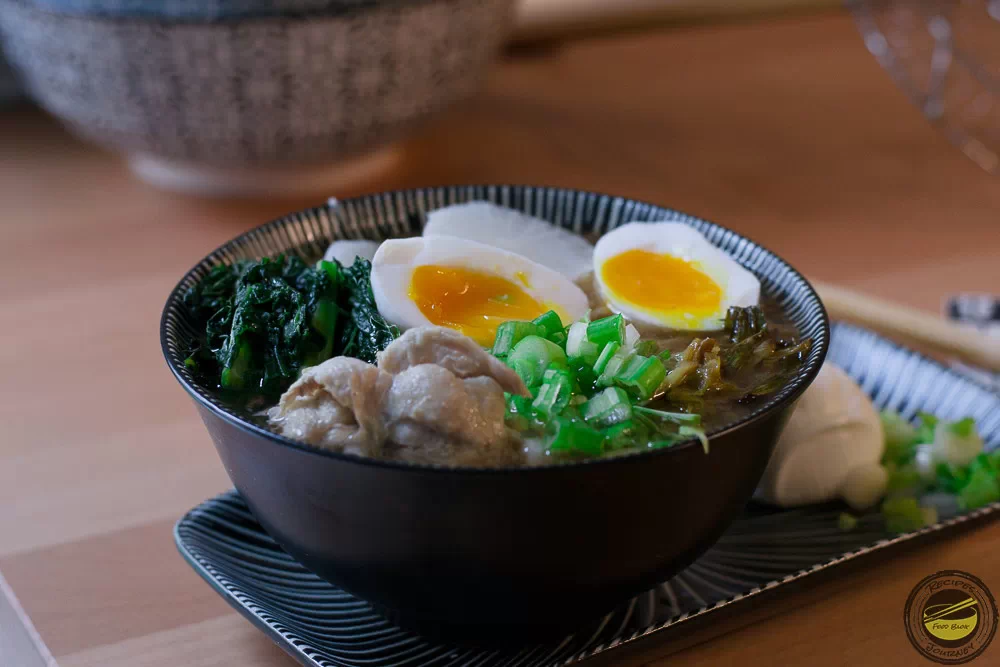Questo articolo è disponibile anche in: ![]() Italian
Italian
Today I finally want to introduce one of my favourite dishes, indeed it would be better to say that I introduce you to my obsession: Japanese Ramen. I have always been intrigued by Ramen, I grew up with cartoons from Japan, and then I became a lover of anime, an example? Well, how not to mention Naruto! Moreover, he is not only a great lover of ramen, but even bears the name of one of the toppings of this dish!
Ramen is the recipe on which I carry out real compulsive research, in order to perfect it more and more. Starting from finding the original ingredients, to how to create them, as I did with kansui, being able to prepare fresh Ramen Noodles instead of buying dry ones, which are delicious but are completely different. The techniques, the various methods of preparation, without forgetting the original recipes of the territory and of course, the experimentation to create my bowls.
From here we start with a guide that will talk about Japanese Ramen in all its aspects, so that all lovers of this dish can have the information, notions and even recipes to be able to prepare The Japanese Ramen at home.
Origins And History Of Japanese Ramen
Japanese cuisine includes a variety of dishes and recipes. Ramen is one of the most important dishes not only in Japan, but around the world due to its versatility. Ramen is a soup made up of wheat noodles, broth based on meat, fish or vegetables, a sauce that defines its type, an aromatic oil and garnished with various toppings such as Chashu, Menma, Kamaboko, corn and many others. It’s truly a special dish that knows how to give a lot of satisfaction in every aspect, visual, olfactory and obviously gustatory!
The most accredited history of ramen dates back to the Sino-Japanese (Sino-Japanese) war. At the end of it, this dish was imported from China to Japan. The name of the original Chinese dish is Lanzhou Ramen, a soup quite different from Japanese Ramen. Chinese Ramen dates back to about 4000 years ago, is simple, and still embodies its ancient traditions today. The noodles are cooked for a very short time, immersed in the broth prepared with beef, seasoned with salt and a mix of other spices.
Japanese Ramen, on the other hand, has evolved, adapting to the various specialities and ingredients of the different areas of Japan. One of the main differences is the fact that the broth is seasoned portion by portion with the Tare (or Motodare) and aromatic oils, to give different nuances of taste to the broth. The Tare doesn’t have a single recipe, there are several (actually infinite) and it’s mainly thanks to it, that so many types of ramen are developed.
The Development Of Ramen Styles
The history of Japanese Ramen, sees a real spread at the end of the Second World War, it was a very simple soup more similar to the Chinese type or Udon in broth (Kake Udon) or simple noodles in broth, with the addition of some topping. But over time, different types of ramen developed:
- Classic Ramen: abundant not thick soup, ramen noodles, Tare, aromatic oil and topping;
- Tsukemen Ramen: little soup on average or highly dense, the tare is much denser than in classic ramen, aromatic oil, sauce for soaking the noodles apart, topping. In some cases, the soup is not even present. Similar service to Zaru – Soba, Zaru – Udon and Kamaage – Udon;
- Mazemen or Aemen Ramen: very little very thick soup, in some cases even absent, Tare, aromatic oil and topping. Service similar to Abura – Soba;
These three groups represent the three styles of service let’s say, because Japanese Ramen is distinguished in many other ways, for example according to the city of origin, according to the type of broth or according to the tare. We will see these in specific articles so as not to create too much confusion with excessive information.
However, the evolution of this dish doesn’t stop there. Over time, products from other parts of the world such as tomatoes or dried tomatoes, dried porcini or Parmesan have been, and are being introduced, since the latter three contain the famous Umami. Fish-based and even completely vegetarian ramen were born.

The Components of Ramen
Ramen can contain a myriad of different ingredients, but the parts that make it up are 5:
- Ramen Noodles
- Broth
- Tare
- Aromatic Oil
- Topping
The combination of these five elements, if well-balanced, give life to truly extraordinary dishes. In the next few articles, I will talk specifically about each of them, and beyond. I decided to create a real series on Japanese Ramen, where I will describe each of its parts, to better understand its nature, types, styles and to ensure that all those who love this dish as much as I do or are simply curious about it, can try this preparation that seems easy, but it is not.
But you must not be discouraged for this! Because I assure you that in recent years every effort, every mistake, has been repaid over time. I certainly cannot say that I have arrived at the definitive recipe, because I know that I still have a lot to do, but I have reached a point where I can start talking about it more concretely, and sharing what I have learned over the years. In order to make it easier for you to approach the preparation of Ramen.
I hope you enjoy this series, and be a good guide for those like me who have been completely hooked on Japanese Ramen!
Itadakimasu!!

